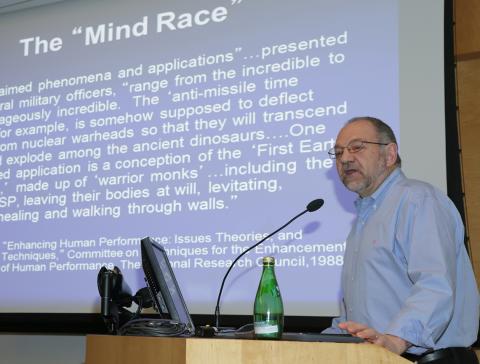‘Military’ Uses of Neuroscience Have Tended to Stumble, Moreno Says

Photo: Bill Branson
At the height of the Cold War more than half a century ago, LSD research failed the acid test when investigators, hoping the drug would render its takers unable to lie, found instead that users were unable to be coherent.
In the intervening decades, many attempts by U.S. military and security interests to harvest discoveries in neurobiology and psychology for their own uses have fallen as flat as an unwittingly dosed soldier, staggering stoned in a meadow.
And as improbable as it sounds, given recent advances in medicine and technology, the old standbys—sex, alcohol and propaganda—remain the cheapest and most effective tools for bending minds.
So reported Dr. Jonathan Moreno, a philosopher and historian at the University of Pennsylvania who spoke at NIH Jan. 11 on a topic that was also the title of his 2006 book: Mind Wars: Brain Science and the Military in the 21st Century.
With projects such as the BRAIN Initiative and a European big-data effort known as the Human Brain Project under way, we are now in the “era of Big Neuroscience,” said Moreno. It is a growth industry, now about 15 years old, driven largely by advances in technology.
But for every scientist who sees functional magnetic resonance imaging as a way to advance human health, there is a tactician who wonders if fMRI can be used to scan the thoughts and plans of a potential terrorist.
Moreno reviewed a host of attempts to apply medical knowledge to spycraft, including the use of mescaline as a truth serum, and psychedelics as ego-suppressants and mind-controllers whereby “you could make a discreet man indiscreet.”
History, and YouTube (check out Operation Moneybags or Operation Midnight Climax), provide a record of follies undertaken as part of the once-secret MK ULTRA program, which sought to employ LSD as a secret-revealer.

Photo: Bill Branson
The CIA and the Army lost interest in LSD by the late 1950s, Moreno said, “but commanders have always been concerned about the mind…Every era tries to capitalize on the mind-control technology of the times.”
In addition to the arms race, there is also a “mind race” in which enhanced human performance is the goal, Moreno said. One of his colleagues is writing a book whose premise is that all wars in human history have been explicitly drug-dependent, including stimulants and depressants. Recently, there have been widespread reports of ISIS reliance on Captagon, the stimulant cousin of Adderall, to create fearless warriors.
Among the current arsenal of science-based tools, according to Moreno, are: modafinil, a type of amphetamine used by fighters and pilots to sustain concentration; the so-called “trust drug” oxytocin, for use in interrogation; the beta-blocker propranolol, thought to suppress pangs of conscience; a variety of brain-imaging techniques designed either to read minds or impel behaviors; lie detectors that rely on brain waves; and creation of armed robotic warriors that use sophisticated face-recognition algorithms to identify enemies.
Moreno is under no illusion about the seriousness of the effort to recruit scientific knowledge to tactical advantage; a 2011 study of military expenditures in the cognitive neurosciences showed $55 million for the Army, $34 million for the Navy, $24 million for the Air Force and more than $240 million for DARPA, “not to mention the millions of dollars invested in black budgets.”
He recommends ELSI—ethical, legal and social implications—research “before it is too late” for any emerging technologies that could conceivably be weaponized. Moreno also said society should be vigilant when entities such as the Defense Intelligence Agency and Office of Naval Research invest heavily in the neurosciences.
But he also grew up, literally, in a mental hospital; his dad was a psychiatrist who specialized in role-playing therapy. He is intimately acquainted with science’s limitations in controlling human behavior.
“Color me a skeptic about much of [federal investments in blue-sky technologies] ever being deployed. It’s flashy and it’s fascinating, but there’s no budget [compared with conventional weaponry] for it.”
